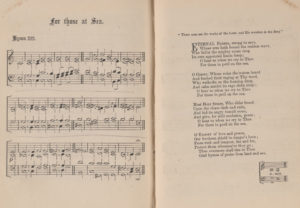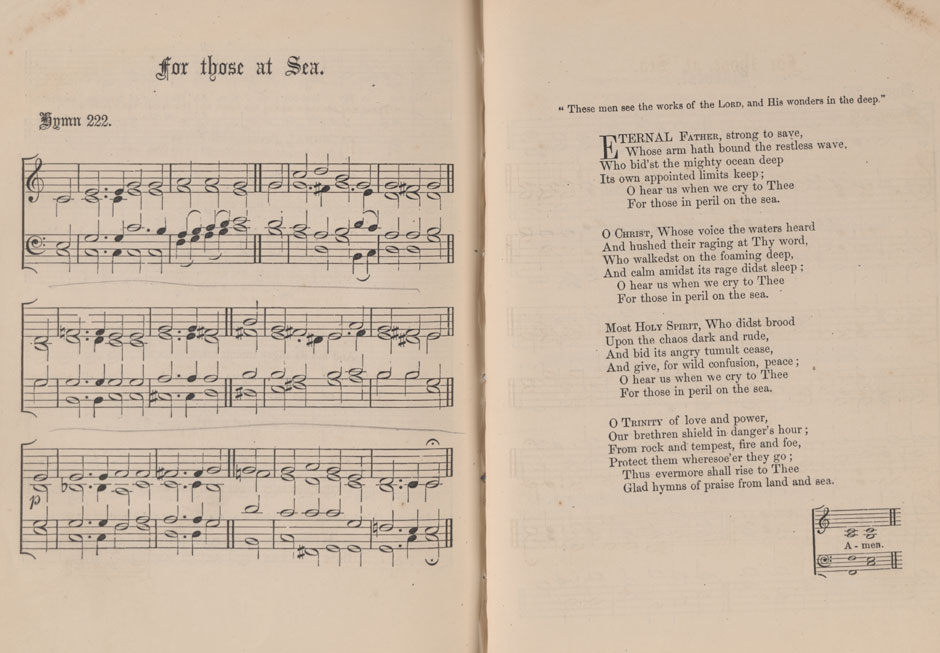As the ninth edition of the hymnal Ancient & Modern has been published — the most popular stable of hymnbooks in the Church of England — here is a little Ancient & Modern history, followed by a few thoughts on what the 21st century holds for hymnbooks.
For my review of the ninth edition of Ancient & Modern, see Ancient & Modern: a review.
A little Ancient & Modern history
The history of Hymns Ancient & Modern begins with a chance meeting on a train between two hymnal editors. In 1852, Francis Murray had published the Hymnal for Use in the English Church; William Denton had produced his Church Hymnal in the following year. Both were Tractarians, and their publications were part of a great flood of hymnals that rode in the wake of the Oxford Movement. Much of the content of these hymnals were archaeological recoveries of ancient and mediaeval hymns in Latin and Greek. John Mason Neale‘s Hymnal Noted (1852 & 1854) is the prime example of this tradition. Murray and Denton’s conversation on the train seems to have been about the problem of a profusion of hymnals targeted at the various niche congregations within the church. They gathered a group of hymnologists to form the future ‘proprietors’ of Hymns Ancient & Modern. Denton only remained with the project for a few months (possibly because the 1855 second edition of the Church Hymnal was starting to sell more copies), but the proprietors were now ably led by Henry Baker with William Henry Monk as music editor. They produced a trial selection of 138 hymns in 1859. In 1861, most of these found their way into the collection of 273 hymns

The subsequent appearance of the Appendix to the hymnal in 1868 showed a desire to keep the book fresh. In 1875, Monk produced the second edition, being the first in a line of composers to steer the project, and it was this edition that cornered the hymnal market in the church. It was so popular that the 1904 New and Revised Edition, which was otherwise a perfectly decent third edition, was roundly rejected for rearranging hymns and giving them new numbers. This forced the proprietors to abandon it and return to the popular, previous edition of Monk, bound with its supplement by Charles Steggall (1889), which became known contrastingly as the ‘Old Complete Edition’. In 1916, a second supplement was added by Sydney Nicholson, and, in 1922, he lightly edited the hymnal to produce the Standard Edition.
Gerald Hocken Knight and John Dykes Bower took over as editors, producing the more heavily edited Revised Edition in 1950, adding new hymns and removing those that had not stood the test of time. In 1983 the pruning continued, with almost half of the hymns in the Revised Edition being removed and all 200 of the combined contents of 100 Hymns for Today (1969) and More Hymns for Today (1980) being uncritically added without being dispersed among the remnant, producing the New Standard Edition. Both the Revised (AMR) and the New Standard (AMNS) editions remain in use in many churches. In 2000, the hymnal was rebranded Common Praise as an accompaniment to the liturgy of Common Worship. Common Praise included a fair number of hymns that were traditionally indicative of the rival stable of the New English Hymnal, which encouraged some churches and cathedrals that used the latter to make the switch, and continued the concept of it being a single hymnal of broad appeal. The supplement Sing Praise was produced in 2010 (New English Praise, a similar supplement to New English Hymnal came out in 2006). In 2013, these two were combined and edited together as Ancient & Modern, dropping the Hymns from the title.
A 21st-century hymnal?
Some might question the need for hymnals in the digital age. A minority of churches use digital projectors to ‘shew forth’ hymn and liturgical texts for their congregations. Though this emphasizes the corporate nature of worship — singing from the same hymn sheet! — it can make worship something observed, something virtual. Only once in my life have I been to an Anglican church where everyone had a single volume of the Prayer Book bound with a hymnal, and that was in rural Co. Antrim. Most other churches present the worshipper with more or fewer books, booklets and sheets. Increasingly, hymn texts for the service are printed on a pew sheet, and hymnbooks have become the preserve of the choir and organist, and a resource directory for those who select hymns for services. The trend for ever larger hymnals (the latest edition of Mission Praise has 1250 entries) suggests that compilers recognise that the hymnbook has become more of a resource than an aid in worship, placing inclusion ahead of exclusion. It would be good to have a large scale survey of churches using this hymnal, at some point in the future, to see what the usage rate of each item is.
I commented before that it would take 2½ years to sing through all 847 items without repeating one, given four hymns every Sunday morning and three in the evening. Of course, there are always going to be some hymns that are not to the taste of clergy, musicians and congregations, and others that are repeat favourites. Some of the liturgical items might be used week in, week out, or not at all. The question is how many hymns does an individual church need at any given time. A cheeky answer might be: only the few that we are singing in this service. However, my question is how big can an individual church’s repertoire of hymnody be. I am sure there is some variation here. One response would be to create print-on-demand hymnals tailored to a church’s choices and traditions, yet perhaps this might take us back to the disunity that Francis Murray and William Denton deplored when they met that day on the train.
For my review of the ninth edition of Ancient & Modern, see Ancient & Modern: a review.

Pingback: fmi
Pingback: Ancient & Modern: a review – Liturgy guru